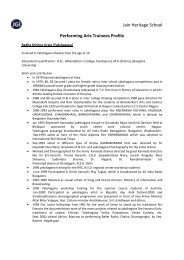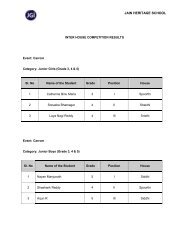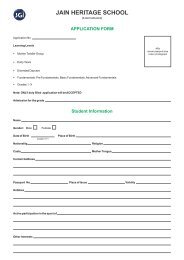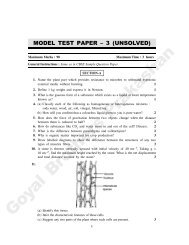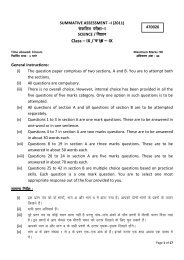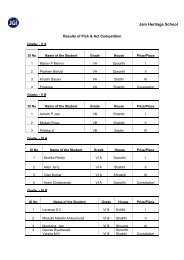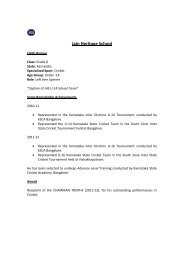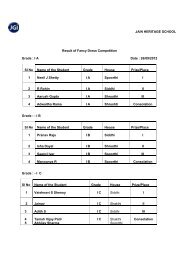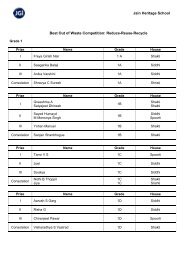Secondary School Curriculum 2012 - Central Board of Secondary ...
Secondary School Curriculum 2012 - Central Board of Secondary ...
Secondary School Curriculum 2012 - Central Board of Secondary ...
You also want an ePaper? Increase the reach of your titles
YUMPU automatically turns print PDFs into web optimized ePapers that Google loves.
(a)<br />
Themes<br />
The Ancient Regime and its crises. (b) The<br />
social forces that led to the revolution. (c)<br />
The different revolutionary groups and<br />
ideas <strong>of</strong> the time. (d) The legacy.<br />
(Chapter-1)<br />
2. Russian Revolution.<br />
(a) The crises <strong>of</strong> Tzarism. (b) The nature <strong>of</strong><br />
social movements between 1905 and<br />
1917. (c) The First World War and<br />
foundation <strong>of</strong> Soviet state. (d) The legacy.<br />
(Chapter 2)<br />
3. Rise <strong>of</strong> Nazism.<br />
(a) The growth <strong>of</strong> social democracy (b) The<br />
crises in Germany. (b) The basis <strong>of</strong> Hitler's<br />
rise to power. (c) The ideology <strong>of</strong> Nazism.<br />
(d) The impact <strong>of</strong> Nazism. (Chapter 3)<br />
Term II<br />
Sub-unit 1.2 : Economies and Livelihoods<br />
The themes in this section will focus on how different<br />
social groups grapple with the changes in the<br />
contemporary world and how these changes affect<br />
their lives.<br />
Any two themes <strong>of</strong> the following :<br />
4. Pastoralists in the modern world.<br />
(a) Pastoralism as a way <strong>of</strong> life. (b) Different<br />
forms <strong>of</strong> pastoralism. (c) What happens<br />
to pastoralism under colonialism and<br />
modern states?<br />
Case studies : focus on two pastoral<br />
groups, one from Africa and one from<br />
India. (Chapter 5)<br />
5. Forest society and colonialism :<br />
(a) Relationship between forests and<br />
livelihoods. (b) Changes in forest societies<br />
under colonialism.<br />
Case studies : focus on two forest<br />
movements one in colonial India (Bastar)<br />
and one in Indonesia. (Chapter 4)<br />
<br />
<br />
<br />
<br />
<br />
<br />
<br />
<br />
<br />
Objectives<br />
<strong>of</strong> the Russian revolution.<br />
Familiarize students with the names <strong>of</strong> people<br />
involved, the different types <strong>of</strong> ideas that inspired<br />
the revolution.<br />
Discuss the critical significance <strong>of</strong> Nazism in<br />
shaping the politics <strong>of</strong> modern world.<br />
Familiarize students with the speeches and<br />
writings <strong>of</strong> Nazi leaders.<br />
Consider what happens to pastoralists and<br />
pastoralism in the modern world, with the<br />
formation <strong>of</strong> modern states, marking <strong>of</strong><br />
boundaries, processes <strong>of</strong> sedentarization,<br />
contraction <strong>of</strong> pastures, and expansion <strong>of</strong><br />
markets.<br />
Point to the varying patterns <strong>of</strong> developments<br />
within pastoral societies in different places.<br />
Look at the impact <strong>of</strong> colonialism on forest<br />
societies, and the implication <strong>of</strong> scientific forestry.<br />
Discuss the social and cultural world <strong>of</strong> forest<br />
communities through the study <strong>of</strong> specific<br />
revolts.<br />
Understand how oral traditions can be used to<br />
explore tribal revolts.<br />
Show the different processes through which<br />
agrarian transformation may occur in the modern<br />
world.<br />
122



